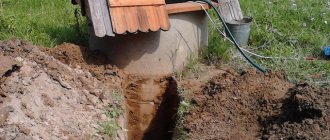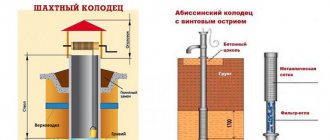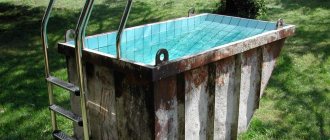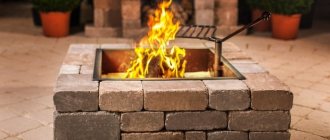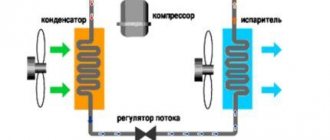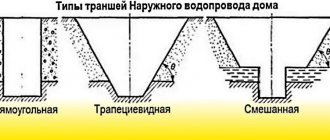Some owners of country houses and dachas use houses for residence only in the warm season, organizing an appropriate autonomous water supply from a well or well. After the end of their stay with the onset of cold weather, many homeowners are faced with the question of how to drain the water from the water supply system for the winter.
Not only the external and internal pipelines, but also the automatic elements of the electric pump and pumping equipment will have to be freed from water masses. The task is not so simple due to the presence in the house of a large number of plumbing and household electrical appliances, the operation of which is related to water consumption and residual water can be stored in these devices for a long time.
Rice. 1 Draining water from a house into a well - an example of a diagram of how to drain water from a water supply system for the winter
Blowing pipes for the winter
One of the important elements in the garden is the water supply.
Without watering, especially in dry summers, it is quite difficult to grow a good harvest. Mulch helps retain moisture in the soil, but this moisture must still be added to the soil. Therefore, periodic watering of plants is necessary. To organize irrigation in a garden plot, a water supply system of one of three types is made. The first type of plumbing is its absence. Along the border of the garden plot there is a common water supply system, in which there is a tap for watering the plot. The advantage of such a system is that there are no pipes on the site and they do not interfere. The downside is that you need to carry a long, heavy hose from the tap, which damages the plants and destroys the beds.
The second type of water supply is above ground. The pipes are located on the surface of the garden plot. Plus - the system is easy to install, it is easy to drain water from it for the winter. The downside is that the pipes get in the way.
The third type of water supply is underground. The pipes are located underground at a depth of more than 30 cm.
Plus, the pipes don’t get in the way. Disadvantages - more labor-intensive and expensive construction of the system, the need to remove water for the winter.
Despite the disadvantages, underground water supply is more preferable for a garden plot, especially if landscaping is done on it.
Water can be supplied to each bed and the plants can be watered on them with a hose or a drip irrigation tape can be installed.
You can also place underground hidden water points on the site, covered with lids. We connect hoses or irrigation devices to the points during watering.
When installing underground water supply, it is optimal to use polypropylene pipes that are resistant to freezing in winter. That is, if water remains in them and turns into ice, then the pipe expands under the influence of ice. And when the ice melts in the spring, it narrows, but remains intact.
However, it is better to remove water from the pipes in the fall. If only for the reason that in the spring the ice in the pipe will not melt immediately and the pipes will not be able to be used at this time. For example, in 2014, the pipes thawed only on May 5th.
There are two ways to remove water from pipes.
The first is to lay the pipes at an angle when installing the water supply system and install a tap at the lowest point to drain the water in the fall.
The second is to blow air through the pipes. A household compressor will not work here, as it has weak outgoing air pressure. Over a long pipe length, the pressure decreases greatly and water is practically not blown out of it.
To ensure guaranteed water removal, you need to connect to the system with a pipe with a diameter of 12-34 inches and high air pressure. It's easy to do it yourself. You will need: a membrane expansion tank for the heating system, fittings, a compressor for the car, a piece of hose and clamps.
The essence of blowing pipes is as follows: we pump air into the expansion tank with a compressor, then we connect the tank with a hose to the water supply system and supply air from the tank into it. At the same time, water flies out noisily from open taps. Family members and neighbors within a radius of three hundred meters must be warned about this in advance.
The expansion tank is a metal container in which a membrane is located - a rubber container. When heated, water in the heating system expands and fills the membrane. The expansion of water is restrained by air pressure, which is pumped into the gap between the membrane and the tank body. Air is pumped through a valve at the end of the tank using a car compressor.
A membrane prevents us from using the tank to blow out pipes. We unscrew the tank flange, remove the membrane and screw the flange into place. Next, screw the tap onto the flange thread. If the thread is inch, then first install adapter 1-34.
Then the tap and place an adapter on it to connect the hose. We install the same adapter on any faucet of the water supply system. Next, we put the hose on the adapters and clamp them securely using clamps. It is important! When you open the tap, air under high pressure enters the hose, and if it is not secured, it can be torn off the adapter. And this is fraught with minor injury.
So, the hose was installed and securely fastened. Next, we connect a car compressor to the tank valve and pump air into it to a pressure of 6-8 bar.
Then we open the taps in the water supply system and open the tap on the tank. Air noisily enters the pipes and blows water out of them.
When organizing purge, you need to take into account that the longer the pipes in the system, the more air will be needed to purge them. The amount of air depends on the volume of the expansion tank. The larger the tank, the larger the system can be purged with it.
If you have a pipe 5-15 meters long, then a tank with a volume of 20-30 liters will be enough. Longer lengths will require tanks of 50-100 liters. Or you can use a smaller tank, but blow out the long system in parts.
In my opinion, it is better to immediately purchase an expansion tank of 80-100 liters and permanently install it somewhere in the workshop. You will have your own compressor station providing you with high pressure air. Moreover, an ordinary automobile pump will act as a compressor. You never know where you need high pressure air! Blow out the water from the pipes, blow out the air filter, etc.
Preparing the water supply for frost
The most painful place in a summer cottage is the water supply; a temperature of -1° can be detrimental to it. If it is not insulated for the winter and is not used during the cold period, the following work must be carried out.
- Shut off the general water supply to the area, open the taps along the entire length of the water supply. The liquid will leave the system by gravity.
- A compressor can be used for pumping out. To do this, turn off the liquid supply taps on the manifold, connect the unit to the pipe, create a pressure of 4 atmospheres and open one valve. Water under pressure will come out of the system. Repeat manipulations with each line.
- The water from the filters in the house must be drained, and the faucets must be dismantled.
- If the pipes lie on the surface or are buried shallowly, they should additionally be wrapped with any insulation, secured with weights or buried.
Air purging
Unlike water, which is a practically incompressible liquid, air has very high compressibility. It is this property that allows it to be used in shock absorbers. But the high degree of air compressibility requires the use of a sufficiently powerful compressor for effective blowing; a car compressor is not suitable for these purposes. With a long pipe length, the pressure of the pumped air quickly drops, which does not allow the remaining water to be effectively blown out.
Blowing the water supply after draining the tap
To blow out the water supply system, pressure and air flow are important.
Do not use too powerful compressors, since the pipes used for internal wiring are designed for a maximum pressure of 8-10 atmospheres. To blow through a complex and extensive water supply system in a multi-story cottage, a large volume of air will be required.
Preparatory work for the winter period in the bathroom
The first step is to remove the hoses and shower heads installed in the shower and then drain the water from them. A minimal preparation process is expected in sewers equipped with plastic sections, including plastic siphons, which create a very small water plug. It should also be noted that plastic has excellent thermal insulation characteristics, unlike metal and ceramics. The ability of plastic to deform will not allow the siphon to be damaged if the remaining water turns into an ice mass.
In the case of equipment with cast iron siphons, removing the remaining water is a mandatory procedure. What needs to be done in this case? Pushing water from the siphon is carried out using a kvach (otherwise known as a plunger). If this is not available, this task can be accomplished using a bicycle or machine pump. Alternatively, you can soak up the water in the drain with a regular rag. At the end of this process, the drain hole is tightly plugged with a stopper in order to avoid the appearance of sewer smell inside the room.
At the next stage, they begin to work on the toilet, which has the largest water plug, located in the knee bend of the bowl of the structure. Porcelain has very low deformation characteristics, which can cause the lower part of the knee to break off when residual water freezes in it.
Work order:
- It is necessary to drain the water from the toilet tank several times;
- Shut off the valve leading to the tank and completely remove any remaining water from it;
- Check that there is no water in the tank by opening its lid. If necessary, remove residues with a sponge;
- Scoop out the water from the toilet;
- To prevent sewer odors from appearing in the room, the hole should be plugged with a regular rag.
Equipment: what to blow with?
If you cannot find a powerful compressor, you can use the property of air to accumulate kinetic energy during compression. In other words, to blow out the water supply we will use a receiver, a compressed air storage device. For these purposes, we will use a hydraulic accumulator, which is designed to stabilize the water supply to taps and can hold air under pressure of up to 10 atmospheres. The procedure is as follows: a car compressor gradually pumps air into the bulb or membrane of the hydraulic tank, the hydraulic tank is connected to the water supply system through a hose, open all the taps at the water intake points and turn on the air supply from the hydraulic tank. We will see the effect of purging - water will come out of the pipes under pressure, quickly and with great noise.
Recommendations
It makes sense to leave the devices open for a while and let the moisture dry out. This can be done indoors where there is no wind and dust does not fly. This requirement is especially significant for equipment that is sensitive to solid particles. Breakage will not happen, but the abrasive will damage the mechanical components.
It is necessary to drain any water from flexible hoses that may remain in the kinks. To do this, the hose must be lifted sequentially until liquid stops flowing from the end hole. There is nothing complicated. The main thing is to show a little attention, and the spring mood will not be overshadowed by anything.
Compressor types
Compressors operating on various principles can be used to purify water pipes.
different types of air compressors
Piston compressor
Air is compressed in piston cylinders, a direct analogy is the compression of the combustible mixture in an internal combustion engine. Low price, simple design, maintainability. High noise level during operation, impossibility of long-term operation.
Screw compressor
I pump air into two complex-shaped screws in parallel rotation. Low noise level during operation. Low friction between the screws ensures low power consumption. High energy efficiency - a large volume of pumped air per unit of energy spent. The cost is higher than piston compressors, repairs are only carried out under specialized service conditions.
Scroll compressor
Compact size, convenient for use in small spaces, relatively low productivity.
Diaphragm compressor
Similar to a piston, but instead of a metal piston a thin membrane is used. The membrane is driven by a crank mechanism. Low pressure generated, not very high level of performance.
industrial compressor
Compressors are often equipped with a small receiver. This is a durable steel tank in which compressed air is stored. The presence of a receiver allows you to increase the pressure to high values, which the compressor itself cannot provide, and organize a supply of air. As a result, we get an effective replacement for an expensive, powerful compressor.
The compressor is always equipped with a pressure gauge and control means. This is necessary to monitor and correct pressure levels. After purging the water supply system, all drain valves located at the lower points of different pipe branches should be left open.
Pump Applications
In the practice of running a private household or just the normal operation of your home, situations often arise when you urgently need to pump out water. Each such case has its own characteristics and the need to use special pumping equipment. The matter concerns primarily the following series of events:
- Groundwater.
The most common event in the life of a private home is the filling of basements, basements and other rooms located below the ground level with groundwater. Such a rise can often occur completely unexpectedly for the owners, rapidly and without reasons noticeable at first glance. These may be seasonal floods, heavy rainfall, melting snow and glaciers.
However, even if a flooding event is foreseen, the only thing that can save the situation is the timely use of pumping equipment of sufficient power. The longer the water remains in the structures, the higher the degree of impact of destructive factors on them.
Pumping groundwater from a flooded basement Source propodval.ru
- Improper or clogged drainage.
The second common reason why a basement suddenly floods is a faulty drainage system. It can either become clogged or be initially installed incorrectly. In both cases, the system requires inspection and repair.
However, before you begin any troubleshooting steps, you need to use a pump to pump water out of the basement. In addition, builders often save on the project and do not equip the drainage system. In this case, after eliminating the element, the owner will still have to make efforts to create it.
- Crack in the foundation.
If the foundation of the house is cracked, sooner or later, when the conditions are right, water will begin to seep into the basement or basement. This will be especially evident during heavy rainfalls or floods.
Water from under the house will have to be removed one way or another to avoid the consequences of prolonged exposure to dampness on the structure. At the same time, in order to avoid a repetition of such an event in the future, it is necessary to find and repair the foundation defect.
Water may seep into the basement due to damaged waterproofing as a result of a crack in the foundation Source infradom.ru
- Capillary moisture
Water under a building may not penetrate suddenly, as during a disaster, but gradually. In this case, the capillary effect operates - when water seeps in small volumes, but almost continuously.
This phenomenon is most often caused by the lack of waterproofing or its improper arrangement. In any case, a special pump will have to be used to eliminate flooding. An automatically operating pump works best in this situation.
On a note! A specialized pump is useful not only for periodically pumping water from basements, but also in various everyday circumstances - for example, when you need to drain a well for repairs, or renew an artificial reservoir, or pump up a storage tank from a lake for watering a garden, or pump out water that is flooded after rain. car repair pit.
Stages of purging water pipes
All pipeline purging is divided into several successive stages:
- We turn off the water and disconnect the purged system from the external water intake source.
- We drain the water from it.
- We twist the plugs, disconnect the plumbing fixtures and other appliances.
- We remove visible blockages.
- We connect the compressor pipe to one edge of the pipe.
- Turn on the compressor.
- We observe the other edge of the pipe. We turn off the compressor only after all the water has flowed out.
- For insurance, you can repeat this procedure in the opposite direction.
- After disconnecting the compressor, during conservation, both edges of the pipeline are closed with plugs, which prevents it from clogging. If the water supply continues to be used, all plumbing and appliances are connected to it, and water is supplied through it.
In this way, it is possible to efficiently bleed the summer water supply and prepare it for the winter, or carry out a high-quality cleaning of it.
Do-it-yourself septic tank conservation
In year-round country houses, the septic tank does not freeze, but when the owners leave for the whole winter, work on its insulation cannot be neglected.
To preserve a septic tank for the winter, you need to:
- disconnect it from electricity;
- disconnect pumps and air compressors;
- pump out the liquid from the septic tank by ¾ (or add water, but the septic tank should be a quarter full!).
- pour bacteria into the septic tank (this will get rid of unpleasant odors after re-opening)
- insulate the septic tank lid and pipeline with any insulation.
This is the neck liner for insulating a septic tank made by our participant with the nickname Ice9avalon.
If there are still concerns that the walls of the septic tank may freeze, throw a five-liter bottle half filled with water into each section.
Then the ice, expanding, will compress the plastic of the bottle, and not the plastic of the septic tank.
Having completed all this work, you can leave the dacha with a clear conscience until spring - in spring the autonomous water supply and sewerage systems will work like new.
Compressors and their variants
Let us consider in more detail the possible options for this equipment, which differ in individual characteristics.
Here, air is compressed in piston cylinders according to the operating principle of an internal combustion engine. The advantage of this type is the simplicity of the design, its maintainability and low cost. The disadvantage is the limited operating time and noise of this process.
This type is distinguished by its small dimensions and low productivity. Its work occurs as a result of the interaction of two helices. Such equipment is suitable for blowing short-length pipes with small diameters.
The operating principle of such a device is based on the parallel rotation of two special screws. Due to low friction, this process requires little electricity and is characterized by low noise.
On the other hand, it should be noted the high productivity of this design. He is able to create sufficient pressure. Due to the complexity of the design, such products are very expensive and difficult to repair.
This type is similar to the piston design. A membrane is used instead of a piston. Its features are low efficiency and low pressure. To increase power, a small receiver is used in which compressed air is stored.
As a result of the combined work of these two elements, low-power equipment is capable of creating high pressure. This way you can significantly save your family budget. After all, to purify the water supply of a private house or cottage, there is no need to buy powerful equipment.
Devices for creating winter water supply
The main devices are:
- pipes;
- surface or submersible pump;
- drain valve;
- pressure switch;
- hydraulic accumulator;
- water heating cable.
Pipes for winter water supply
It is better to choose polypropylene pipes, because they have a number of advantages:
- do not rust;
- durable (up to 50 years);
- low thermal conductivity;
- low weight;
- easy to install;
- acoustically isolated.
Installation is performed by thermal welding, which ensures the integrity and safety of the entire system.
Surface or submersible pump for winter water supply
The best option would be to use a submersible pump. It supplies water well to the system and is economical.
You need to choose the brand yourself, which depends on the depth of the water source and the type.
Natural cooling of the engine is carried out automatically, and during operation it does not create any noise.
Drain valve for winter water supply
The valve is installed after the pump, and the water can be drained into a source or into a well.
You can build a bypass pipe instead of the drain valve. This option is good when the winter water supply is located near the house.
Pressure switch for winter water supply
The device is necessary to maintain the pressure in the water supply within a certain range.
When the maximum pressure is reached, the relay will turn off the pump. If the pressure drops to a minimum, the relay will close the contacts and the pump will resume operation.
Hydraulic accumulator for winter water supply
This device will protect the water supply from water hammer and stabilize the pressure.
If the electricity suddenly goes out, you will still have water, since the water that has accumulated in the tank will enter the system.
It is better to use a hydraulic storage tank with a membrane.
Winter water heater
In practice, storage water heaters cope best with this process.
The power and volume of the boiler must be selected based on your water consumption. Typically, for a family of 5 people, 100 liters with a power of 2.5 kW is enough.
If winter water supply is carried out near the house, then you will need a water heating cable. It can be placed in the basement or under the floor.
Making your own compressor
In order to blow out pipes for the winter, it is not necessary to purchase factory-made equipment. You can make it yourself, using available materials. For this you will need:
- take a canister, equip it with a water hose and fitting;
- the edge of the disconnected water supply is connected to the hose;
- a car pump is connected to the fitting;
- using a pump, pressure is created in the canister, which pushes water out of the pipes.
Naturally, the power of such a manual device will be insufficient, but it will be enough to blow through pipes of small diameter and length. The advantage of such a device is its independence from electricity and other power sources.
How to insulate a well
Modern wells are made from reinforced concrete rings. This is a material with high thermal conductivity, and it will freeze. There is a particularly high risk of freezing in shallow wells, with a water level no higher than 1.1 - 1.2 meters, and in wells located in cold regions.
In regions with a temperate climate, it is enough to simply close the well tightly for the winter, or make a reliable house on top without cracks - the cold penetrates through the cracks, falls down and thus freezes the shaft.
Protasevich Consultant FORUMHOUSE
In a tightly closed well, the rings in frost are approximately 0.5-0.7 meters below ground level. The concrete rings themselves will not “conduct” the cold to the bottom.
But insulation of wells is also welcomed in the Moscow region. Frozen water in a well can damage pumping equipment, displacement of rings, and discrepancies in the joints between them.
Wells that are not insulated for the winter are more likely to need repairs.
If you have a blind area, you can insulate it too.
You can buy a ready-made “shell” for insulating wells, or you can insulate the structure with polystyrene foam or extruded polystyrene foam (these options are used by FORUMHOUSE members more often than others.
Recommendations
Comments 69
Good idea, I forgot to drain it the second fall, but strangely enough the pipes are intact, but I have 20 and I realized that you have 34
no difference. tees with 3/4 threads are also available for the 20th pipe. I chose the 3/4 thread because it is more difficult to insert a nipple into the 1/2″ plug.
I wish there were more Kulibins like this. thanks for the advice
I also blow out all the pipes at the dacha before frosts, only the device is a little different and with a receiver, it seems more effective to me. www.google.com/url?q=http…rPjpOfttRY_KRa8Ob4Kfsym0g I’ve been using it for 3 years now and not a single pipe has broken.
We’ve been doing this for a long time too, the only pumping station we have is 20 meters from the house, and it takes a long time for one person to run, but for two people it takes 15 minutes, from the house and from watering... In the house through a mixer: one monitors the pump, the second opens the tap...
I worked on landscaping and did watering. For the winter, the water was removed using a compressor and receiver. A regular pump won’t get it all out, although there will be a little left, and maybe it won’t tear it.
I use a compressor, nothing has broken in four years, HDPE pipe
but I don’t kick it out...it rips, of course after the winter...I patch it with rations of fresh pieces of pipe...I’m just too lazy to cut 40 meters in the fall, collect it, put it somewhere. But it rips in only three to five places. this is less in terms of soldering than the entire cut mainline and soldered again
I do this: Since the pipe is slightly sunk into the ground so as not to get in the way underfoot, in the fall I buy the most inexpensive antifreeze and pour it into the pipes from the house through the taps and shower hose, in turn cold to the supply pipe and hot to the bottom point where the drain krantik. Then I use a pedal pump to blow out the residue. 2 liters of antifreeze diluted in half is enough for the eyes. I pour the rest into the sink and shower siphons. In the spring, I pumped water into the pipes, washed 20 liters into a bucket and that’s it. To prevent farts from vomiting: this is industrial water, wash the dishes or use the water heater in the shower. At the inlet there is a filter with resin. For 7 years, no one was poisoned. ))) I get something to drink from the well.
Pump up the pressure and quickly release it through the far tap - water mixed with air comes out.
HDPE with a blue stripe doesn’t really care about the frost, you just need to open the taps. Otherwise, you can’t get all the water out; there will be sagging in the pipes and it will return there.
But the sellers say that if there is no slope, it will tear in 2-3 years...
Trusting the seller means not respecting yourself.
A guy already wrote here... PVC pipe and no problems with defrosting and freezing. Just leave the taps open in time. It’s inexpensive... Why all these hemorrhoids?
So don't do it. If you don't need it, don't do it. What's the problem? Do you want to prove to me that the pipe is not bursting? Well, prove it. I'm vomiting and I made this device for myself. It's inexpensive, you say? This adapter costs 5 rubles. This, dude, turns me on - if you come up with something, there will definitely be people who will crap everything. Like, what the heck, we’ll buy it, they have it in China, etc. If you don’t want to, don’t do it, no one is forcing you, aphids, done for yourself! Thanks for understanding.
Are you an idiot? Do you have a spring exacerbation? Where did you find sir in my text? I won’t prove anything to the idiot, no one’s pvc vomits, the idiot does. Yes, write as much as you like, fuck...
don’t do nonsense all the water from a hose or pipe in this way you won’t be able to squeeze out air lighter than water at a certain moment the air will begin to come out of the pipe passing through the pipe on top of the water if there is no slope then you won’t be able to remove all the water from the pipe
They will pump more air... Ahahaha
exactly, use a pump to expel the water so that the pipes don’t burst)
I laid a reinforced garden hose in the ground and forgot about the frozen pipes.
I would do it under the pump; it pumps air faster, but it seems to me that my father-in-law and I also drain the dead poultice, just unscrew it like you did and first insert the electric pump from the boat into the exhaust pipe, and that’s it.
And here the pumping speed does not matter. Excess pressure will still be created and will displace the water. However, I repeat, this is an idea. I implemented it this way, but you can at least adapt a turbine from a rocket engine - it’s up to you, however.
I’m not offended, I’m saying how we do it, and it’s right that whoever wants to do it the way he wants.
And here the pumping speed does not matter. Excess pressure will still be created and will displace the water. However, I repeat, this is an idea. I implemented it this way, but you can at least adapt a turbine from a rocket engine - it’s up to you, however.
I also pumped it up with an auto-compressor at the highest point of the water supply, and went around opening the taps. For five years, not a single impulse.
Features and algorithm of actions when starting a pumping station
Installation, grounding and startup of the pumping station must be carried out by a specialist who is authorized and qualified to carry out this work. If this condition is met, there will be no reason to refuse warranty repairs if the pump breaks down. However, a competent and skilled man can independently connect the station by reading the instructions and observing safety precautions.
The pumping station is installed in an insulated room and is protected from exposure to negative temperatures or flooding. Considering the noise level of the unit, it is necessary to place it away from living rooms or provide a soundproof casing, which, by the way, can simultaneously serve as insulation. The station must be rigidly fixed to a concrete base or steel frame. Requires 220 V power supply.
Before starting a new pumping station for the first time, it is necessary to check the air pressure in the accumulator. It should be within 1.4-1.7 atm. for small containers up to 25 l; 1.7-1.9 atm. for larger ones. For measurements, an autopump with a pressure gauge is used; it can also pump air through the valve if necessary.
To properly start the pumping station for the first time, the following work should be done step by step:
- Place the station on a hard, flat surface and secure it.
- Check the hydraulic accumulator. When the tank is empty, the standard pressure is 1.5 atm. If it is more, you need to bleed the air through the nipple, less - pump it up.
- At the initial suction point, install a check valve with a coarse filter mesh on the pipe and lower it into the water intake. The angle of inclination of the suction line from the pump to the source must be 10 degrees or more to the horizon. For suction, rigid metal or HDPE pipes are used, as well as reinforced hoses with a diameter of 25-32 mm.
- Connect the suction line to the inlet pipe on the housing.
- Connect the pressure line through the connecting piece.
- Fill the pump and suction pipe with water: open the filling hole on the body, closed with a plug or valve; pour until the liquid begins to flow back; close tightly.
- Connect the power cable to a grounded outlet and press start.
- Open the nearest tap to bleed any remaining air from the water supply.
- After 3-5 minutes of pump operation, water should flow from the tap. If this does not happen: turn off the station, refill water, start again.
Small installation tricks
Before starting work, a diagram or design of the water supply system is drawn up. The diagram must include all elements of the system with a calculation of the diameter of the pipes used and the number of auxiliary parts (couplings, fittings, volume of insulating material). It is better to prepare a trench for the pipeline in dry and warm weather.
Step-by-step installation instructions:
- Project preparation.
- Preparing the trench.
- Preparing the pump and hydraulic system, checking the configuration.
- Insulation and installation of pipes in the trench.
- Installation of water intake elements in the well (you must remember that you will have to drill concrete rings in the well to install the water intake element, so you must have an impact drill or other powerful tool).
- Connection of all installed elements to each other.
- If the wiring in the house is installed in advance, the system is immediately checked for leaks. If the water supply is uninterrupted, then the trench is subject to further insulation and covering with soil, if necessary.
The tightness of the water supply structure at the joints is ensured using a special silicone-based sealant.
Criterias of choice
When choosing pumping equipment for use in a private household, you need to pay attention to the following parameters:
- Lifting height. The characteristic directly determines the scope of application of the installation.
- Water source debit. Affects the choice of device power and the purpose of its use. For example, if it is necessary to completely drain a basement, pit or well, despite a constant influx of water, the pump capacity must significantly exceed the inflow value.
- The head or operating pressure created by the equipment. The indicator affects the distance from the intake point to the drain point.
Externally installed pumps have quite a strong pressure Source elektroportal.ru
Ash will permanently rid your home of rodents
Once upon a time, people noticed that mice did not live in houses built on ashes for several years. The fact is that rodents really don’t like ash, because it contains alkali and strongly corrodes the animal’s paws. Moreover, the animal has to constantly lick it off, as a result of which the irritation spreads to the oral cavity and stomach. To combat rodents, you need to grind the ash into powder, and then sprinkle it on the dry floors of the basement and cellar at the rate of one bucket per 5-10 sq.m. The only downside to this method is that animals will spread small particles of ash throughout the house, and you will have to constantly clean up.
